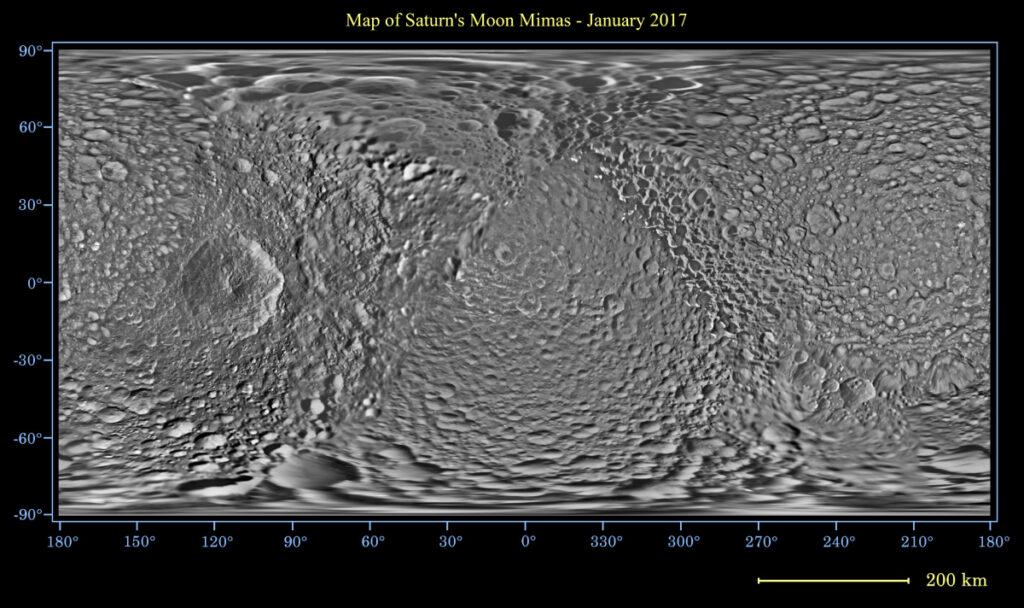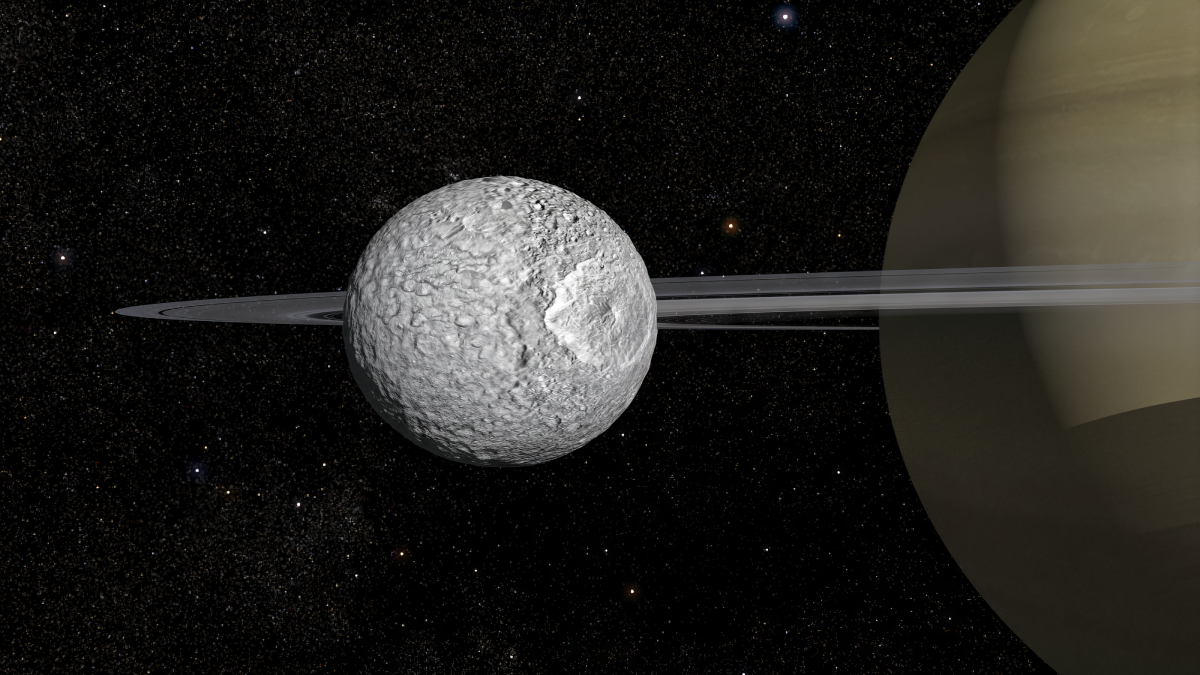Saturn’s moon Mimas, famous for its “Death Star” crater, likely harbors a subsurface ocean. A new analysis of images taken by NASA’s Cassini spacecraft has revealed that tiny changes in Mimas’s orbit can be explained only if the moon hosts an ocean beneath 20–30 kilometers of ice.
The research, published in Nature, adds an unlikely member to the small roster of ocean worlds in the solar system and furthers our understanding Saturn’s chaotic history.
“If even Mimas can get an ocean, then almost any object could hide an ocean,” said Valéry Lainey, an astronomer at Observatoire de Paris in France and lead researcher on the discovery.
A Tiny Shift with Big Implications
In the solar system, only Jupiter’s Europa, Callisto, and Ganymede and Saturn’s Enceladus and Titan have confirmed oceans, but several more moons of Saturn, Uranus, and Neptune are the subject of fierce speculation and proposed exploration.
But Mimas’s small size and cratered surface make it an unlikely candidate for an ocean world.
“If you wanted to bet on which body gets a global ocean, you will never bet on Mimas.”
“If you wanted to bet on which body gets a global ocean, you will never bet on Mimas,” Lainey said.
Mimas, the innermost of Saturn’s major moons, is not quite 400 kilometers (250 miles) across. Its pockmarks suggest that no new material has erupted and smoothed out the surface in a while. It’s best recognized for its 130-kilometer Herschel Crater, which makes it resemble the Death Star from the Star Wars franchise.
Measurements by the Cassini spacecraft revealed that Mimas’s rotation evolves in an unexpected way. Instead of always showing the same face to Saturn the way the Moon does to Earth, Mimas’s Saturn-facing hemisphere rocks back and forth in a cycle known as libration. The strength of the libration made scientists suspect in a 2014 study that beneath Mimas’s surface was either a completely frozen moon with an oblong core or a subsurface ocean layer.
“Given how different Mimas looks from confirmed ocean moons like Enceladus, most of us figured the frozen model was probably correct,” said Alyssa Rhoden, a planetary scientist at the Southwest Research Institute in Boulder, Colo., who was not involved with this research.
Lainey and his team reanalyzed the old Cassini data, supplemented with data from the Hubble Space Telescope. They used tens of thousands of Cassini images of Mimas and 18 other Saturnian moons and looked at not just changes to Mimas’s rotation but its orbit around Saturn, too.
The researchers measured that the closest point in Mimas’s orbit to Saturn, its periapsis, had drifted 9.4 kilometers (less than 6 miles) over Cassini’s 13 years at Saturn, roughly 0.15° counterclockwise around the planet. The shift was tiny, but it was enough for the team’s orbital simulations to home in on an answer.
“There is no way to explain both the rotation and the orbital motion of Mimas with a rigid core,” Lainey said. “Whatever the size and whatever the shape of the silicate core, there is no way you can have a rigid interior. You must have liquid water and an icy shell that slips on the surface.”
Their simulation suggests that Mimas’s subsurface ocean rests under 20–30 kilometers of ice. As much as 50%–60% of Mimas’s total volume could be liquid water, Lainey said.

Combined with the 2014 study, this new research makes “a very strong case for an internal ocean within Mimas today,” Rhoden said. “I wouldn’t say it’s ‘confirmed’ or ‘definitive,’ but I would say it’s highly likely and worth dedicated exploration.”
“We are past the point of an internal ocean in Mimas being simply possible—it’s now plausible,” said Matthew Walker, a planetary scientist at the Planetary Science Institute in Tucson, Ariz., who was not involved with this study. There’s always the possibility some unknown mechanism could cause the libration and orbital drift without an ocean, Walker said, so he would not discourage other scientists from investigating other options. Still, “it seems most likely that there is an ocean there,” he said.
Stealthy Ocean World
The analysis suggests that Mimas’s ocean could be as young as 2 million years old. The team postulated that the relatively young ocean hasn’t yet had time to change Mimas’s surface in a visible way like what occurred on Europa or Enceladus. Mimas could very well look more like Enceladus in a few million years, Lainey said.
The Saturn system, with its rings and plentiful moons, has had an eventful history. Mimas’s interior could have melted from additional tidal heat during a shift in gravitational alignment or the expulsion of a moon.
If a moon as small and as cratered as Mimas could have a subsurface ocean, ocean worlds might be even more common than previously thought.
“Mimas is almost certainly the most stealthy ocean world.”
“Mimas is almost certainly the most stealthy ocean world,” Rhoden said. Other confirmed or suspected ocean worlds around Saturn and Uranus, for example, show more evidence than Mimas has of having oceans now or in their recent past—geysers, tectonic features, young surfaces, and/or high heat flows.
“Ocean moons at Uranus seem even more plausible in light of the Mimas results,” Rhoden said.
“That Mimas quite probably does have an ocean under that cratered crust demonstrates that we cannot just rely on tiger stripes, double ridges, or chaos terrains to indicate to us the presence of an ocean,” Walker said. By identifying ocean worlds through their orbital characteristics, “we can then use the surface geology of these worlds to tell us about the stages and life cycles of any ocean worlds that we observe.”
—Kimberly M. S. Cartier (@AstroKimCartier), Staff Writer

